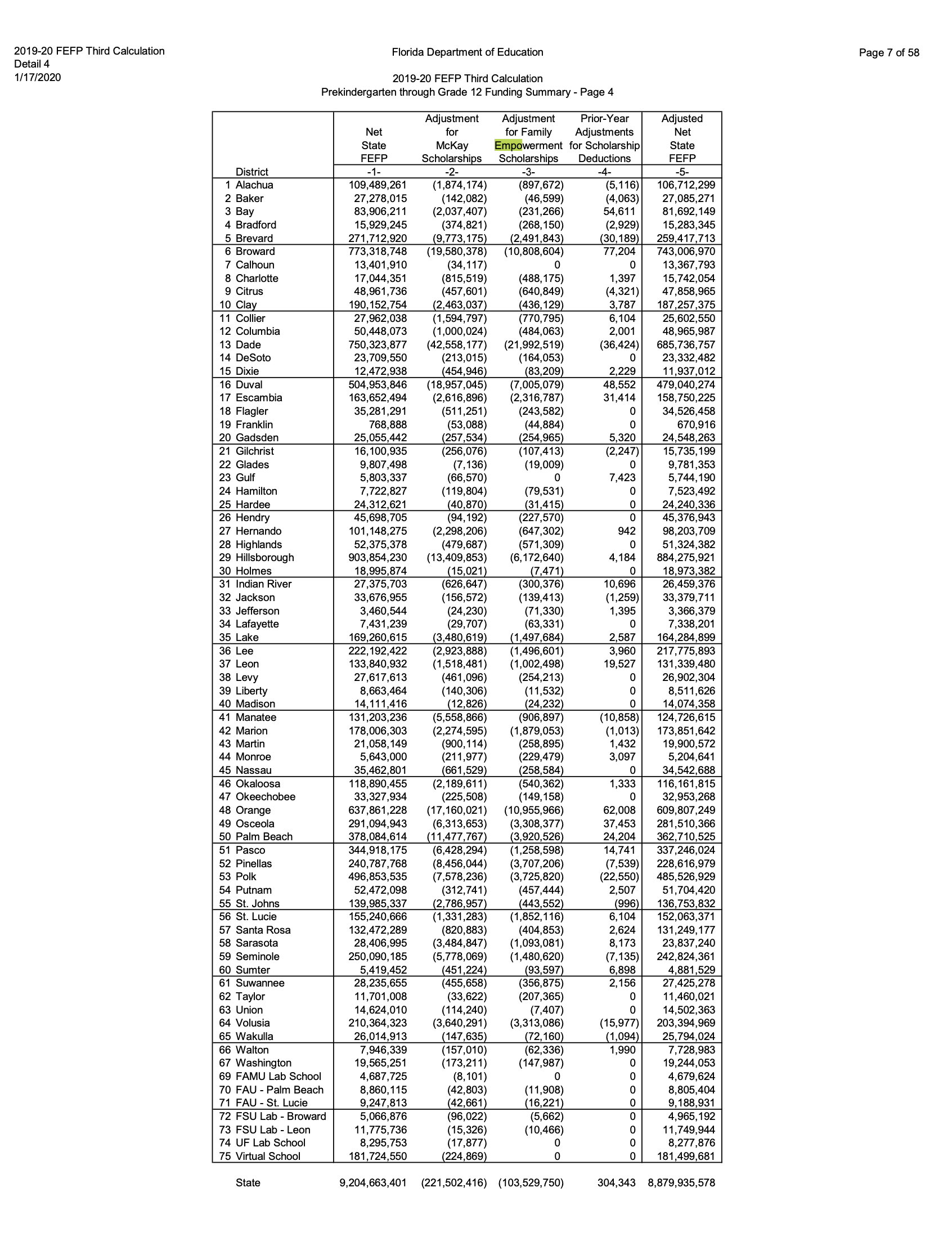Actually, Chair Sullivan, It IS “an And/Or”
As we wrote previously, HB7067 (and its companion SB1220), by quadrupling the current annual enrollment growth rate and placing income thresholds on an automatic escalator for the state’s new, directly funded Florida Empowerment Scholarship (FES), could result in massive voucher expansion. Initially sold as a program for families with “limited financial resources,” it won’t take long before everyone qualifies, further defunding our public schools along the way. Both bills will be voted on in their respective chambers in the upcoming week.
In its inaugural year, 17,724 (out of a maximum 18,000) FES vouchers were funded through the Florida Education Finance Program (FEFP) at a cost of $103.5 MILLION to our State’s public schools. During HB7067 questions on the House floor on 3/6/2020, Miami Rep. Javier Fernandez asked bill sponsor, House Education Committee Chair Jennifer Sullivan, why the automatic expansion provisions were needed if the program currently had capacity. Sullivan replied “Since we had remaining money, remaining capacity, we want to accommodate families who are just over (the income cap).” Sullivan later responded to a question from Osceola Rep. John Cortes, saying “if there is scholarship money left over, we’re going to increase (the family income eligibility cap) from 300-325% (of the FPL) so that more students can qualify because we have extra money.”
To be clear, that “extra money” Chair Sullivan is referring to is CURRENTLY BEING SPENT BY OUR PUBLIC SCHOOLS for the education of our public school students; it is not left over, waiting to be spent. Also, current law, already, allows the program to grow by 7,000 students each year, which seems adequate for a program that has yet to reach capacity.
Orlando Rep. Anna Eskamani wondered whether funds wouldn’t be better spent this year funding public schools, citing the need for increased teacher pay, rather than rapidly expanding this new voucher program. Chair Sullivan’s response was, “What I would say… is that I don’t think it’s an and/or, I think it’s both,” claiming she is “all for doing both simultaneously.” But here is the thing: because the FES is funded via the same “pot of money” that our public schools are (the FEFP), expanding one, defunds the other… it is not a “both.” It can only be an “and/or.” And, like last year, the public schools will come out on the losing end.
Shortly after he took office, Governor Ron DeSantis announced his plan to eliminate the reported waitlist (of 15,000 students) for Florida’s Tax Credit Scholarship (FTCS) by creating a new voucher program. Ultimately, the Family Empowerment Scholarship (FES) was created to serve 18,000 students in 2020 and to automatically increase by 7,000 (0.25% of the total public school population) each year. The initial program had a family income eligibility cap of 300% of the Federal Poverty Limit (FPL) but, like the FTCS, priority is given to students whose family income was at or below 185% of the FPL. Unlike the FTCS, the new FES funds its voucher program directly out of the Florida Education Finance Program (FEFP), the same pool of money that funds Florida’s public schools.
Published on 1/17/20, the FEFP 3rd Calculation Summary, demonstrated just how the new FES voucher would affect their budget. Impact varied between individual districts: Miami-Dade $22 Million, Orange $11 Million, Duval $7 Million, etc., but few districts were left untouched:

In its inaugural year, the FES accomplished its stated goal of eliminating DeSantis’ 15,000 student waitlist by funding 17,724 (out of a maximum 18,000) FES vouchers through the FEFP at a cost of $103.5 MILLION to the State’s public schools. Now, via HB7067/SB1220, lawmakers want to both accelerate the increase in the available number of FES vouchers (from 0.25% of the pupil school population or 7,000 vouchers each year, to 1.0% or 28,000 vouchers each year) AND automatically increase the family income eligibility cap (by 25% of the FPL each year, i.e. from 300% of the FPL to 325% of the FPL initially) if the program is unable to fill the now rapidly increasing capacity.
For the record, assuming similar funding levels, a 28,000 student increase in FES vouchers next year (to 46,000 total) would place the FES at a total cost of ~$268.6 MILLION, more than half the cost of the budgeted $500 Million for teacher pay initiatives.
To be clear (and it is confusing), even without the HB7067/SB1220, the FES, which currently serves 17,724 students, would expand to 25,000 total vouchers available NEXT YEAR (18,000 + 7,000). Since the FES was unable to fill its 18,000 cap this year, it remains to be seen whether the program could fill those 25,000 voucher spots. Also, since THIS year the program DID NOT have more than 5% of the available FES scholarships unawarded (17,724 is 98.5% of 18,000), HB7067/SB1220 would NOT increase the family eligibility cap for the FES next year. (The bills do increase the Florida Tax Credit Scholarship family income eligibility cap from 260% to 300%, to match the FES’s and allow FTCS students to easily transfer to the FES program – perhaps this is where the expected growth is expected to come from.)
If the goal of HB7067/SB1220 is to move voucher recipients from the current FTCS, funded by diverted corporate taxes via a corporate tax credit scheme, to the new FES, directly funded by the FEFP, then the automatic enrollment increases of 28,000/year could make the FTCS obsolete within 4 years.
Does Chair Sullivan really believe that expanding the publicly funded FES voucher program will not come at the expense of our public school children? It was designed to do exactly that.
There is still time to call your legislators and ask them to OPPOSE HB7067 and SB1220. Remind them that a NO vote still allows the current measured expansion of the Family Empowerment, massive expansion is not needed; especially not at the expense of our public schools.

2 Comments